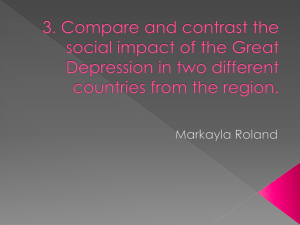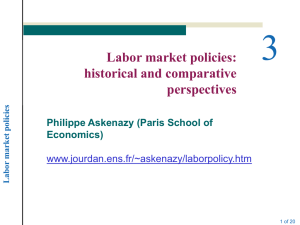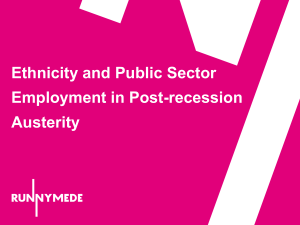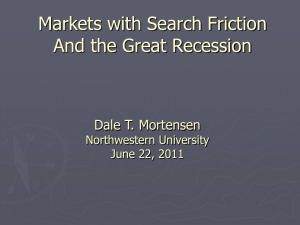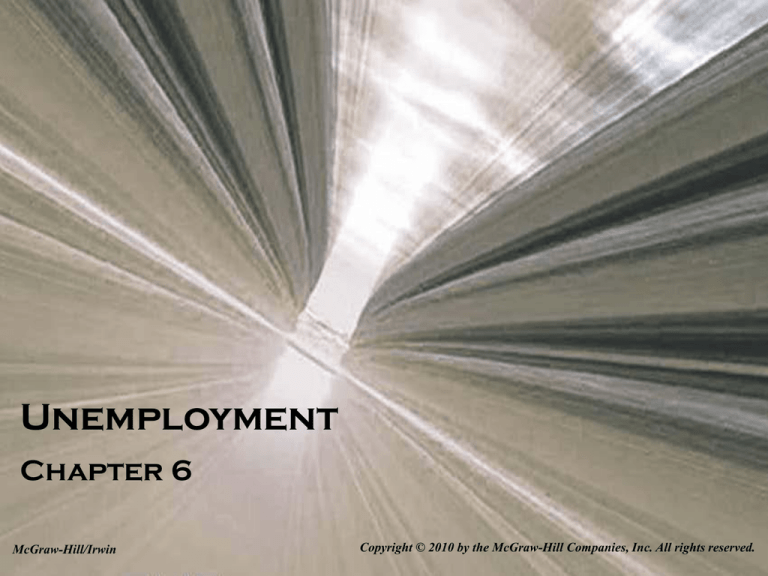
Unemployment
Chapter 6
McGraw-Hill/Irwin
Copyright © 2010 by the McGraw-Hill Companies, Inc. All rights6-1
reserved.
Unemployment
• In this chapter we take a look at the problem of
unemployment
– When is a person “unemployed”?
– What are the costs of unemployment?
– What’s an appropriate policy goal for “full
employment”?
6-2
The Labor Force
• Labor force: All persons age 16 and over who
are either working for pay or actively seeking
paid employment
– People who are not employed or are not actively
seeking work are not considered part of the labor
force
6-3
The Labor Force
• Labor-force participation rate: The
percentage of the working-age population
working or seeking employment
• People who are neither employed nor actively
seeking work are called nonparticipants
6-4
The Labor Force, 2008
Source: U.S. Bureau of Labor Statistics
Only half the total U.S. population participates in the civilian labor force. The
rest of the population is too young, in school, at home, retired, or otherwise
unavailable.
6-5
A Growing Labor Force
Source: Economic Report of the President, 2009
The labor force expands as births and immigration increase. A big increase in
the participation rate of women after 1950 also added to labor-force growth.
6-6
Production Possibilities
• Labor-force growth expands production
possibilities, enabling more production
• Need to create more jobs to assure that laborforce participants can find a job
• Otherwise, could end up inside the production
possibilities curve
6-7
Investment Goods (units per year)
Labor Force Growth
C
A
H
F
Labor-force growth
increases production
possibilities
G
At point F,
resources are
unemployed
O
B
Consumption Goods (units per year)
D
6-8
Unemployment
• To make full use of production capacity an
economy’s labor force must be fully employed
• Unemployment: The inability of labor-force
participants to find jobs
• Okun’s Law: 1 percent more unemployment
results in 2 percent less output
6-9
Measuring Unemployment
• U.S. Census Bureau surveys about 60,000
households a month to determine how many
people are actually unemployed
• A person is considered unemployed if he or
she is not employed and is actively seeking a
job
6-10
The Unemployment Rate
• Unemployment rate: The proportion of the
labor force that is unemployed
number of unemployed people
Unemployment rate
labor force
8,924,000
2008 unemployment rate
5.78%
154,287,000
6-11
Unemployment Varies by Race and Sex
Source: U.S. Department of Labor (2008 data)
Minority groups, teenagers, and less-educated individuals experience higher
rates of unemployment.
6-12
Duration of Unemployment
• When the economy is growing, unemployment
rates and average duration decline
Duration
Percent of
Unemployed
Less than 5 weeks
5 to 14 weeks
15 to 26 weeks
32.80%
31.4
16.0
27 weeks or more
19.7
Median duration
9.4 weeks
Source: U.S. Bureau of Labor Statistics (2008 data)
6-13
Reasons for Unemployment
• How long a person remains unemployed is
affected by the nature of the joblessness
–
–
–
–
Job leavers
Job losers
Reentrants
New entrants
6-14
Reasons for Unemployment
Source: U.S. Labor Department
People become unemployed for various reasons. In recessions, the proportion
of job losers shoots up.
6-15
Discouraged Workers
• Discouraged worker: An individual who isn’t
actively seeking employment but would look
for or accept a job if one were available
• Discouraged workers are not counted as
unemployed because they gave up looking for
a job
6-16
Underemployment
• Underemployment: People seeking full-time
paid employment who work only part-time or
are employed at jobs below their capability
• Underemployed workers represent labor
resources that are not being fully utilized
6-17
The Human Costs
• Prolonged unemployment can hurt, causing
–
–
–
–
Lost income
Lost confidence
Social stress
Ill health
6-18
Defining Full Employment
• Full employment is not the same as zero
unemployment
• There are several types of unemployment
6-19
Seasonal Unemployment
• Seasonal unemployment: Unemployment due
to seasonal changes in employment or labor
supply
• The Labor Department reports seasonally
adjusted unemployment rates for every month
6-20
Frictional Unemployment
• Frictional unemployment: Brief periods of
unemployment experienced by people moving
between jobs or into the labor market
• Differs from other types of unemployment:
– Adequate demand for frictionally unemployed
– They have skills required for existing jobs
– The job-search period is relatively short
6-21
Structural Unemployment
• Structural unemployment: Unemployment
caused by a mismatch between the skills (or
location) of job seekers and the requirements
(or location) of available jobs
6-22
Cyclical Unemployment
• Cyclical unemployment: The unemployment
attributable to the lack of job vacancies, that is,
to an inadequate level of aggregate demand
• Not enough jobs to go around due to
inadequate demand for goods and services
6-23
Slow Growth
• The economy must grow at least as fast as the
labor force to avoid cyclical unemployment
• When economic growth slows below this
threshold, unemployment rates start to rise
6-24
The Unemployment Record
Source: U.S. Department of Labor
Unemployment rates reached record heights (25 percent) during the Great
Depression. In more recent decades, the unemployment rate has varied from
4 percent in full-employment years to over 10 percent in recession years.
6-25
The Full-Employment Goal
• The Employment Act of 1946 committed the
government to pursue maximum employment
• The full employment goal presumably means
avoiding as much cyclical and structural
unemployment as possible, while keeping
frictional unemployment reasonably low
6-26
Inflationary Pressures
• Rising prices are a signal that employment is
nearing capacity
• During the 1960s, the Council of Economic
Advisors placed full employment at a 4%
unemployment rate
6-27
Changes in Structural Unemployment
• During the 1970s and early 1980s structural
barriers to full employment increased
– More youth and women
– Liberal transfer payments
– Structural changes in demand
• The inflation-threshold unemployment rate
was determined to be between 6 and 7 percent
6-28
Declining Structural Pressures
• The structural barriers that intensified
inflationary pressures receded in the 1990s
• Became easier to lower unemployment rates
without increasing inflation
• Bush administration set full-employment
threshold at 5.1 percent in 2004
6-29
The “Natural” Rate of Unemployment
• Natural rate of unemployment: Long-term
rate of unemployment determined by structural
forces in labor and product markets
• The “natural” rate of unemployment consists
of frictional and structural components only
6-30
Congressional Targets
• The Full Employment and Balanced Growth
Act of 1978 (Humphrey-Hawkins Act) set 4%
unemployment rate and 3% inflation as a
national goal
6-31
The Historical Record
• As much as one-fourth of the labor force was
unemployed during the Great Depression
• The unemployment rate fell to 1.2 percent
during World War II and has fluctuated from a
low of 2.8 percent during the Korean War to a
high of 10.8 percent in the 1981-82 recession
6-32
The Historical Record
• From 1982 to 1989 unemployment fell, but
shot up again in the 1990-91 recession
• The rate fell steadily during the last half of the
1990s, but rose sharply in late 2001
• Subsequent recovery pushed the rate down
again in 2006–7
• The credit crisis of 2008 wiped out that gain
6-33
Unemployment
End of Chapter 6
McGraw-Hill/Irwin
Copyright © 2010 by the McGraw-Hill Companies, Inc. All rights6-34
reserved.



